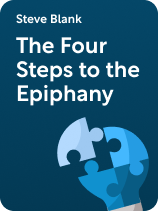

This article is an excerpt from the Shortform book guide to "The Four Steps to the Epiphany" by Steve Blank. Shortform has the world's best summaries and analyses of books you should be reading.
Like this article? Sign up for a free trial here.
How well do you know your customers? Are you correct in your assumptions about what they need and what they think of your product?
Understanding your customers is crucial for business success. It starts with identifying your assumptions about who they are and what they need. Then, you must test these assumptions through real customer feedback and market research.
Keep reading to explore how to transform educated guesses into a solid business strategy that actually works.
Get to Know Your Customers
How well do you know your customers? Blank writes that, as you set out to learn about your market and what direction your company should take, you’ll have to make some assumptions about your customers and how they’ll react to your product. It’s important to clearly identify these assumptions so you can gauge your progress and adjust accordingly throughout the process. Thus, the first stage in finding your customer base is to identify your assumptions.
(Shortform note: Blank’s process for finding your customer base through hypothesizing, testing, and modifying mirrors the scientific method process. The emphasis on clearly identifying assumptions before beginning the customer development process aligns closely with the scientific method’s approach to formulating hypotheses before conducting experiments. This methodology allows startups to systematically test their assumptions about their customer base and market, much like scientists test hypotheses in controlled experiments.)
Identify Your Assumptions
Blank explains that you’ll have to make assumptions about your product itself (benefits and features, release date, and so on), customers (types of customers, what problems you’ll solve for them), pricing, how you’ll create demand for your product, your market type, and how you’ll square up against your competitors. Write a one- to two-page document for each assumption.
For example, you might assume that your product will mostly appeal to teenagers—an assumption about the type of customers you’ll be serving.
| The Lean Canvas Model While Blank recommends creating a separate document for each of your assumptions, other experts suggest a more concise approach. In Running Lean, Ash Maurya recommends writing a single, one-page document encapsulating all of your assumptions, which he refers to as a Lean Canvas. Maurya argues that lengthier business model documents can be time-consuming and can fail to keep up with changing trends. With the Lean Canvas model, you have a succinct, agile document that includes your assumptions about your product, customers, pricing, demand, market type, and competitors for easy reference and revision. However, Maurya does recommend creating a separate Canvas for each customer group you identify in order to meet their unique needs. |
Test Your Assumptions & Make Appropriate Changes
According to Blank, your initial assumptions likely won’t stand up to scrutiny once you start gathering customer input. Reach out to your potential customers to get feedback on your ideas, and determine whether you’ve accurately guessed what their problems are. If you find they have problems you failed to guess or that the things you identified aren’t actually problems for them, do not try to convince them otherwise. Use the information to modify your assumptions about what they need. You should also test your assumptions about the market and your competition—meet with people from other companies in the same field, and examine existing data from analysts about your potential market.
(Shortform note: This step in the process of finding your customers reflects the data gathering stage of the scientific method. In The Black Swan, Nassim Nicholas Taleb emphasizes the importance of empirical skepticism during data collection, warning against logical fallacies like confirmation bias that could lead you to ignore data that don’t support your assumptions in favor of data that do. He argues that you should approach your testing with the aim of falsification—seeking to disprove, rather than prove, your assumptions. This can help startups more quickly identify flawed assumptions, accelerating their learning process so they can avoid wasting resources on ideas that don’t align with customer needs or market realities.)
Share the results of this stage with your entire team, and modify your assumptions documents accordingly. This may mean you need to make a hard pivot—you might need to make drastic changes to your product, shift your focus to a different type of customer, or switch to a different market type. After you’ve modified your assumptions document, seek out customer feedback again and repeat the process until your assumptions align with a profitable business model. This means you must have 1) identified a substantial problem customers face, 2) conceived of a product that will solve that problem, and 3) devised a clear plan for production and distribution that will provide sufficient revenue to outweigh costs and turn a profit.
(Shortform note: In The Lean Startup, Eric Ries explains that it can be difficult to identify when you need to pivot because you’ll rarely find yourself facing complete and utter failure. He recommends regularly meeting with your team to discuss whether you’re on the right track or whether a pivot is necessary. To make it easier to gauge when a shift is necessary, make sure you’re using appropriate metrics rather than vanity metrics. Additionally, make sure your assumptions are clear, and don’t wait too long to pivot—the longer you pursue an unsustainable model without pivoting, the more time, money, and resources you waste.)
Continuing the example, if you’ve assumed your main customers will be teenagers, but then, during the testing stage, you find a greater interest in your product among older adults, you’ll share that information with your team and change your assumptions document to reflect this new knowledge. Then you’ll continue to test and refine until you’re confident you have a solid business plan.
Exercise
- What are two or three key assumptions you’re making about your potential customers and their needs?
- What is one way you could test one of the assumptions you listed above by engaging directly with potential customers? Be specific about how you would reach out and what information you’re seeking.
- Reflecting on Blank’s emphasis on being willing to pivot, how might you change your product idea or target market based on what you learn from customers?

———End of Preview———
Like what you just read? Read the rest of the world's best book summary and analysis of Steve Blank's "The Four Steps to the Epiphany" at Shortform.
Here's what you'll find in our full The Four Steps to the Epiphany summary:
- The four different types of startup markets
- How to identify customer interest in your product
- The three key actions necessary for a startup to grow






